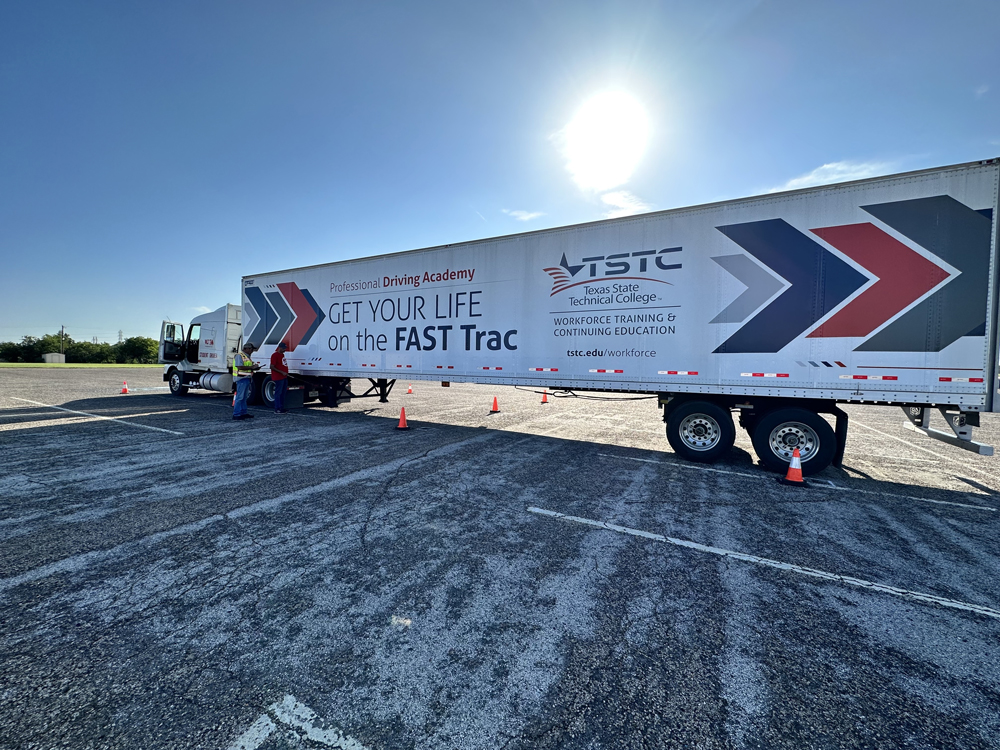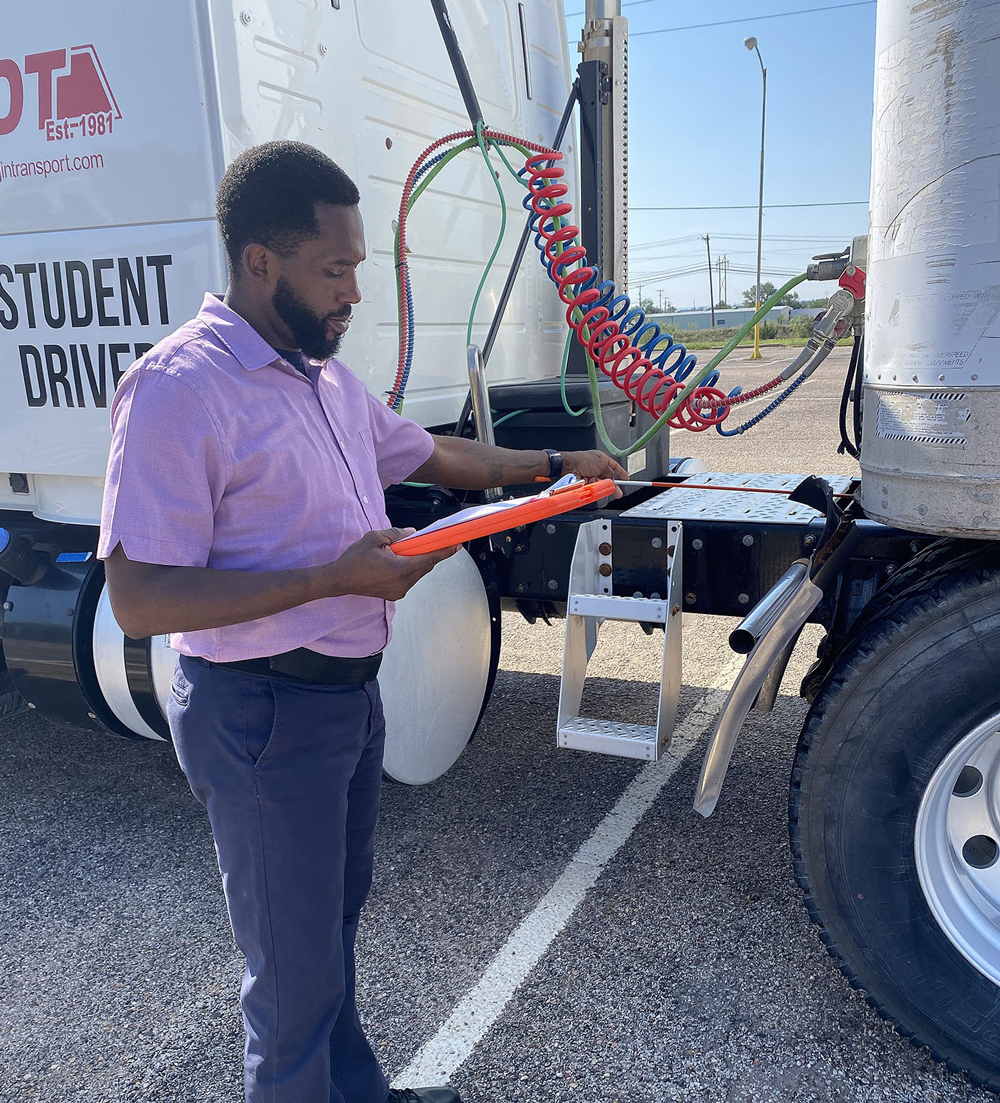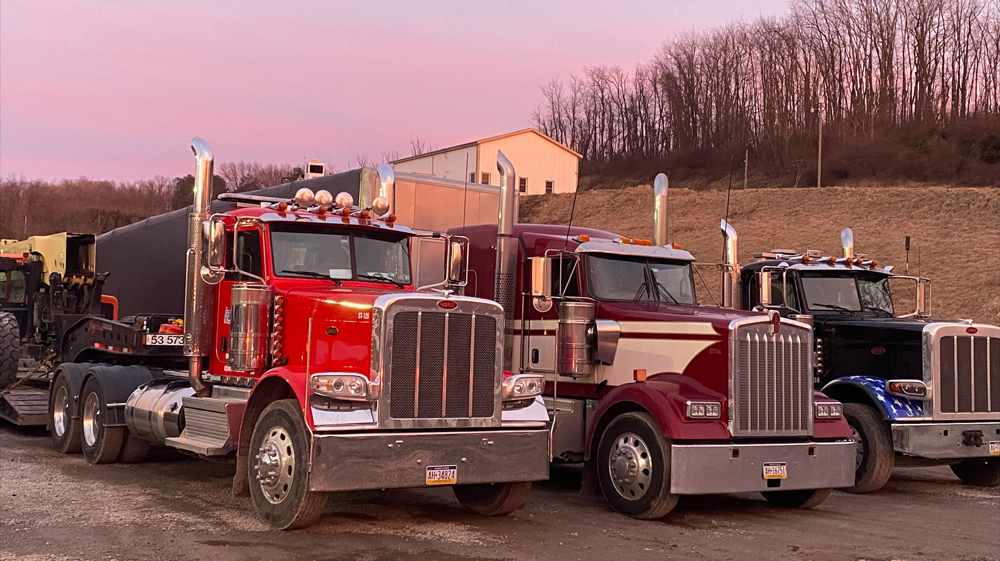July 2023, Vol. 250, No. 7
Features
Specialized Truckers Still Driving Midstream Pipe Deliveries
By Richard McDonough, U.S. Correspondent
(P&GJ) – One of the key and often overlooked facets of the pipeline industry is trucking: transporting raw materials to mills for pipe manufacturing, moving finished pipe to pipe yards—either directly or after initial transit by rail or barge—and transporting the pipe from the yard to the right-of-way.

In the past few years, in particular, this type trucking has been in flux. In the general economy, it’s that oft-mentioned term of “supply chain difficulties.”
In midstream, that’s part of the issue, but the skill levels needed to haul pipe are quite different from the skill levels needed to move a dining room set of furniture or packages for a delivery service. All usually begin, though, at the same starting point – securing a CDL.
A CDL – commercial driver’s license – is required to operate a variety of commercial vehicles, including the types of trucks hauling pipe for the oil and natural gas industry. The initial entry into truck driving in the pipeline industry is typically through a training program at a school.
Texas State Technical College is one of the schools that provides this type of education.
“We train people so they have the knowledge and skills to secure their CDL Class A license,” said Cindy Brunett, executive director of Workforce Training and Continuing Education at Texas State Technical College (TSTC). “Our CDL training course is four weeks long. We provide training at four locations in Texas – Abilene, Fort Bend County, Harlingen and Marshall. Our largest program is in Harlingen.”
TSTC describes itself as “… the only state-supported multiple campus technical college in Texas. We are helping Texas meet the high-tech challenges of today’s global economy in partnership with business and industry, government agencies, and other educational institutions.”
In Texas, a CDL Class A license allows an individual to drive a vehicle with a gross vehicle weight rating of 26,001 pounds or more, according to the State of Texas Department of Public Safety.
Coursework for truck drivers involves a variety of skill-training activities, Burnett explained, including learning how to back up a truck, making turns, checking their loads, safety techniques and other related skills.

She said that almost all of the people who graduate from the CDL training course at TSTC are employed upon graduation. As an example, she cited the class that took this course at the Abilene Campus starting in September 2022. Of the 30 students in that class, Brunett said only one person does not currently have a job.
“There is high demand for truck drivers,” she said. “We work with a number of trucking companies. Many handle basic supply hauling. Some focus on warehousing or farming, while others are in the energy field, including ones hauling equipment for wind farms.”
Beyond the training provided in a school setting, she indicated that many truck drivers get further training when hired by a business.
“We’re training people how to drive a truck,” Brunett said. “The employers are making sure the drivers know how to haul their specific loads.”
In addition to the CDL, other permits may also be required to haul certain products.
“A hazmat endorsement is required for drivers who will be moving oil and chemicals,” noted Brunett. “A tanker endorsement is required for those moving a tanker – whether it be loaded with milk, water, or oil.”
For truck drivers who want to haul pipe for pipelines, there are typically additional requirements – ones that may be set by the transport companies or by their insurance providers.
In particular, transport companies that use trucks to haul pipe look at two additional criteria when hiring truck drivers – time on the road doing specific types of transport and the driver’s age. For example, some firms require truck drivers to be at least 25 years old, while others seek out truck drivers with a certain number of years of experience in hauling heavy loads in other industries.
“We look for drivers with experience in the logging and agriculture industries,” said Dustin Mykyte, president of Pe Ben USA. “We also look for people with experience with lowboy trailers. Many of these drivers are used to moving and backing up trailers. They are used to hard work in rough country.”
Headquartered in Houston, Texas, Pe Ben USA is active throughout the pipeline industry with services ranging from pipe logistics coordination, stringing, transport, pipe yard construction, and related activities.
“The pipeline industry has been in boom-and-bust cycles through the years,” said Mykyte. “We had steady growth – with a few blips – from about 2005 to 2019. It was the longest boom in my 25 years in the industry.”
He noted some events that occurred during the past few years – a glut of oil because of actions taken by Saudi Arabia and Russia, some pipeline construction halted with the change in the Administration in Washington, D.C. and the COVID-19 pandemic – all affected the need for truck drivers to transport pipe, as well as the available supply of truck drivers that could haul pipe.
“A number of the baby boomers retired. Others took more local jobs that paid higher wages. Some were able to get six-figure incomes,” Mykyte said. “It’s hard to compete when you only have a few large projects at a time each year. It’s a big challenge.”
Nonetheless, he believes the future looks brighter, though, compared to the past four plus years.
“We’re working with several engineering companies on large-diameter projects coming in the next few years,” said Mykyte. “We’re ready and willing to work.”
He added that these upcoming pipeline developments include ones that carry carbon, water, oil, or gas. As an example, the firm is heavily involved in a large carbon capture project in the Midwest.
With new pipeline projects in the wings, the need for truck drivers is expected to increase within the industry. Mykyte indicated that Pe Ben USA uses several methods to find and retain truck drivers.
“We have a pretty good list of drivers,” he said. “We treat our employees well. We have a large fleet of safe and comfortable trucks. With our fleet, the oldest truck is from 2017.”
Mykyte said that through the years, “we have had a strong return rate for drivers.”
He also explained that “we work hand-in-hand with the Teamsters Union to recruit truck drivers.”
The union – the International Brotherhood of Teamsters – works with a number of businesses to train drivers in the pipeline industry. These efforts are coordinated through the Teamster National Pipeline Training Fund, which co-chairs.
“The Training Fund is intended to be used to defray expenses for developing the proficiency and skills of drivers in the pipeline industry,” according to a statement from organization. This includes developing or providing training upgrades, apprenticeship programs, and safety training, along with other training and related programs.
Mykyte said that for Pe Ben USA, training is critical.
“We give all of our new drivers a driving test in our yard first,” said Mykyte. “Then we pair the new driver with one of our experienced drivers for a few days – with the experienced driver initially in the driver’s seat. We then have them switch seats. Afterward, we have conversations with both to determine whether additional training might be needed.”
“Driving a truck with pipe is not the same as driving a standard flatbed trailer,” he continued. “You have to take your time and think ahead how to maneuver the truck.”
The challenges to recruit and retain truck drivers in the pipeline industry – and beyond – are expected to continue in the years ahead.
In a statement issued by American Trucking Associations (ATA) on October 25, 2022, the trade organization detailed the extent of the current shortage of truck drivers as well as projections of shortages anticipated in the future.
“Based on our estimates, the trucking industry is short roughly 78,000 drivers.,” according to Bob Costello, Chief Economist of the ATA. “That’s down slightly from 2021’s record of more than 81,000 – but still extremely high historically.”
According to this statement, the “ATA calculates the shortage estimates by determining the difference between the number of drivers currently in the market and the optimal number of drivers based on freight demand.”
Costello noted that “the good news is rising pay and other factors have helped the industry attract new drivers. However, that influx is still not enough to make a substantive difference in the shortage – particularly in the long-haul, for-hire truckload sector, the part of the industry most acutely impacted by the shortage.”
Projections by the ATA, based on current driver demographic trends and projected growth in freight demand, indicated that “the shortage could swell to more than 160,000 over the next decade.”
The ATA said that it is “…the largest national trade association for the trucking industry. Through a federation of 50 affiliated state trucking associations and industry-related conferences and councils, ATA is the voice of the industry America depends on most to move our nation's freight.”
One of those state trucking associations working on the issue of securing more truck drivers is the Texas Trucking Association.
“While there is no silver bullet, we are working with others to encourage more workforce training for truck drivers,” said John Esparza, president and CEO of the Texas Trucking Association (TXTA). “Growth is going to continue. Everything starts with a base of training.”
The TXTA is one of the organizations that is supporting the trucking coursework at schools like Texas State Technical College.
“With the training, the individuals can then gain experience in the field,” Esparza continued. “There is great opportunity in this post-pandemic time.”
Underlying all of the need for truck drivers – actually the need for almost any job, especially ones that require hard work or manual labor – is a shift in American society.
For many, the culture has changed in the United States to a point where simply having a job – a well-paying job – may no longer be the focus of potential workers.
The “life-work balance” may be more important than the paycheck.
“We have to appeal to a different generation,” Esparza said. “At a recent meeting, one of the port officials noted that just because there are eligible hours available doesn’t mean that drivers will take those hours. The life/work balance is now a greater focus for many workers.”
The Pennsylvania Motor Truck Association (PMTA) detailed similar needs for truck drivers in the Commonwealth.
“In Pennsylvania, we estimate the shortage to be around 4,000 drivers,” said Megan Magensky, director of communications of the PMTA. “According to the ATA, the driver shortage is most acute in the longer-haul (i.e., non-local) for-hire truckload market.”
She noted ATA points to some primary factors causing the shortage, including the average age of current drivers, which is high and leads to a large number of retirements. Also, women make up just 8% of drivers.
There are also lifestyle disadvantages, especially in the longer-haul market, with more time away from home required and infrastructure issues like congested highways and a lack of parking spots making it more difficult for drivers to get a spot overnight.
“Companies across Pennsylvania are working hard to address the reasons behind why fewer people are becoming truck drivers,” Magensky continued. “Driver pay has significantly increased over the last few years.”
According to the ATA, 90% of truckload carriers raised driver pay in 2021, and PMTA is working on several community outreach initiatives to encourage young people to join the transportation industry.

One of the businesses cited by the PMTA that move pipe for the midstream industry in the area, TJD Energy Services, LLC, confirmed there is a growing need for truck drivers to serve the energy industry.
“There is a vital need for drivers in Pennsylvania,” said Kristy Capo, Fleet Manager of TJD Energy Services, LLC. “The need for drivers with experience in the gas and oil industry to transport pipe, parts, and equipment for pipeline and gas and oil pad locations is in high demand now.”
TJD Energy Services, based in Washington, Pennsylvania serves the oil and gas industry in the Appalachia Region, in the core areas of the Marcellus Shale, including West Virginia, Ohio and Pennsylvania.
Capo explained that companies are looking for individuals who have “…skills in securing pipe and equipment in a safe and compliant manner in addition to the ability to find the delivery locations. This is a continuous problem because the locations are often remote and not easily accessible to tractor trailers. It can be dangerous and costly if a truck gets off the bonded routes.”
“We as a company have run ads on Indeed and also ads [through] social media accounts including Facebook and LinkedIn,” she continued. “The above three have been successful.”
Given the likely reality that our economy will continue to grow – even if there are times of sluggishness – there will be continued need for new pipelines as well as replacement for existing pipelines. Trucking will be part of that growth.
The role of the truck driver is not one that is likely to be replaced by that other buzzword of today – “artificial intelligence.”
“Quite simply, 88% of our communities in Texas get their goods delivered by truck,” said Esparza of the TXTA. “Even with rail, air, ship and barge, trucking provides the first and last mile of transport for most items.”
That’s true with dining room sets of furniture, and it’s true with pipe for pipelines.
Author: Richard McDonough writes on energy infrastructure-related issues in North America. He can be reached at newsaboutamerica@gmx.us.





Comments